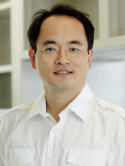Biological significance of the suppression of oxidative phosphorylation in induced pluripotent stem cells Journal Article
| Authors: | Zhang, C.; Skamagki, M.; Liu, Z.; Ananthanarayanan, A.; Zhao, R.; Li, H.; Kim, K. |
| Article Title: | Biological significance of the suppression of oxidative phosphorylation in induced pluripotent stem cells |
| Abstract: | We discovered that induced pluripotent stem cell (iPSC) clones generated from aged tissue donors (A-iPSCs) fail to suppress oxidative phosphorylation. Compared to embryonic stem cells (ESCs) and iPSCs generated from young donors (Y-iPSCs), A-iPSCs show poor expression of the pluripotent stem cell-specific glucose transporter 3 (GLUT3) and impaired glucose uptake, making them unable to support the high glucose demands of glycolysis. Persistent oxidative phosphorylation in A-iPSCs generates higher levels of reactive oxygen species (ROS), which leads to excessive elevation of glutathione (a ROS-scavenging metabolite) and a blunted DNA damage response. These phenotypes were recapitulated in Y-iPSCs by inhibiting pyruvate dehydrogenase kinase (PDK) or supplying citrate to activate oxidative phosphorylation. In addition, oxidative phosphorylation in A-iPSC clones depletes citrate, a nuclear source of acetyl group donors for histone acetylation; this consequently alters histone acetylation status. Expression of GLUT3 in A-iPSCs recovers the metabolic defect, DNA damage response, and histone acetylation status. Zhang et al. demonstrate that GLUT3 suppresses somatic cell-specific oxidative phosphorylation in pluripotent stem cells. Low GLUT3 results in higher glutathione, blunting the DNA damage response, and citrate depletion, reducing histone acetylation. Expression of GLUT3 restores regulation. © 2017 The Authors |
| Keywords: | reactive oxygen species; dna damage response; oxidative phosphorylation; induced pluripotent stem cells; ros; histone acetylation; homeostatic balance |
| Journal Title: | Cell Reports |
| Volume: | 21 |
| Issue: | 8 |
| ISSN: | 2211-1247 |
| Publisher: | Cell Press |
| Date Published: | 2017-11-21 |
| Start Page: | 2058 |
| End Page: | 2065 |
| Language: | English |
| DOI: | 10.1016/j.celrep.2017.10.098 |
| PROVIDER: | scopus |
| PUBMED: | 29166598 |
| PMCID: | PMC5841608 |
| DOI/URL: | |
| Notes: | Article -- Export Date: 2 January 2018 -- Source: Scopus |
Altmetric
Citation Impact
BMJ Impact Analytics
MSK Authors
Related MSK Work






